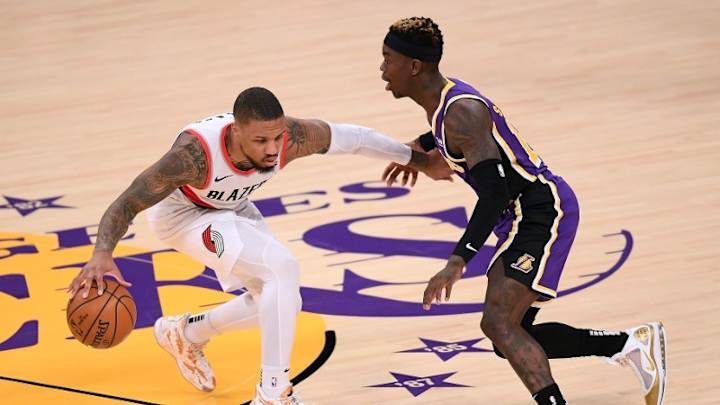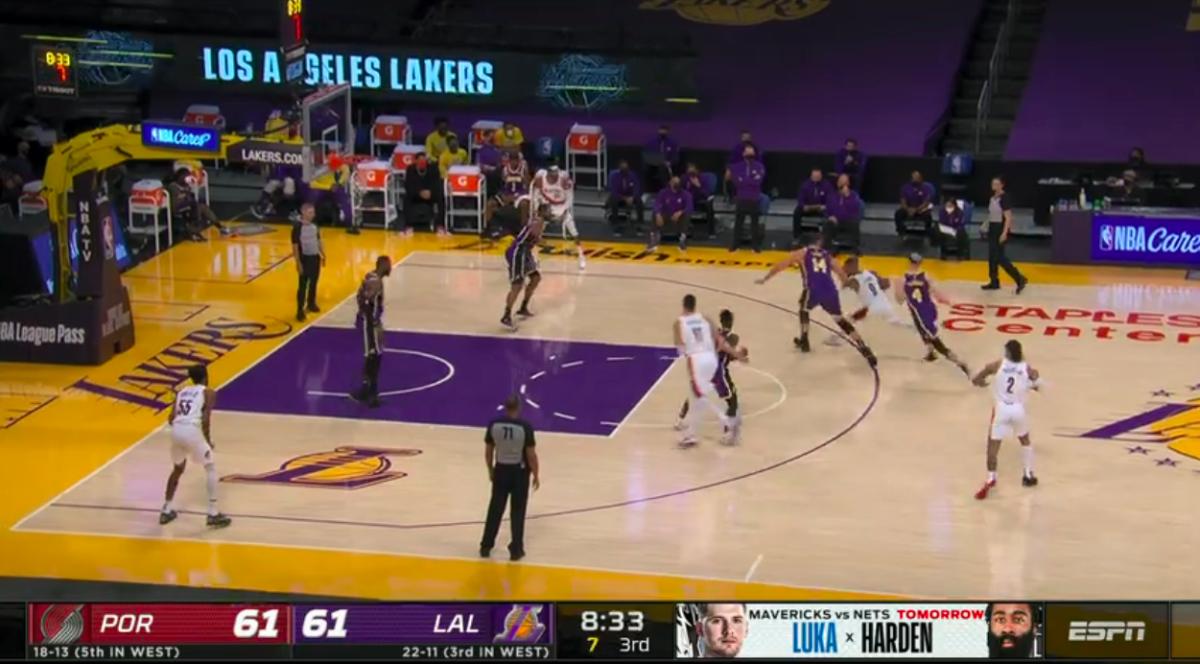Terry Stotts Explains Why Blazers Remain So Reliant on Damian Lillard Ball Screens

Though Damian Lillard scored 24 points in the first half on Friday, he was limited to just a single shot attempt in the third quarter as the Lakers adjusted their defensive scheme to take the ball out of his hands in pick-and-roll. The result for Los Angeles wasn't just slowing Lillard down, but a rash of forced turnovers that ignited its devastating transition attack and eventually put the short-handed Blazers away for good.
The definition of insanity, the saying goes, is doing the same thing again and again while expecting different results. Would Portland have been better off deviating from its main source of offense once the Lakers sold out to stop Lillard ball screens? Not as Terry Stotts saw it.
Asked after the game why his team kept going back to pick-and-roll in the third quarter, the Blazers coach first kept it simple.
"It's what we do, and Dame is one of the best pick-and-roll players in the league."
Portland gets more offense this season out of pick-and-roll than all but four teams in basketball, per NBA.com/stats. Lillard finishes 13.3 possessions per game out of ball-screen action, third-most behind Trae Young and Luka Doncic.
Those stylistic trends are connected, obviously, and date back years. Stotts has prioritized pick-and-roll play as much as any coach in basketball since Lillard and McCollum took the offensive reins in 2015-16. And why not?
There's no point in fixing what isn't broken. The Blazers have been among the several-most efficient ball-screen teams in the NBA for six seasons running. Lillard's low-water mark of .92 points per possession as a pick-and-roll operator came in 2015-16, and still ranked in the 85th percentile, per NBA.com/stats.
But Portland's longtime propensity for running pick-and-roll isn't just about maximizing the strengths of ace shot-makers and ball handlers like Lillard and McCollum. Missing two of their three best offensive players, it's imperative the Blazers make life easier on their supporting cast – and bringing two defenders to the ball, even against a hawking defense like the Lakers', still represents the surest means of doing so.
"When we run those pick-and-rolls it's not necessarily for Dame to be a scorer, but also to hit the roll man," Stotts said. "If they bring two guys to him, then we gotta play 4-on-3."
The numbers advantage created by superstars like Lillard leverages role players' offensive impact to a whole new level. No one else currently available to play, with the possible exception of a hot-shooting Carmelo Anthony, consistently scrambles the defense like Lillard. Putting the ball in his hands at the top of the floor sparks defensive rotations that create scoring opportunities for his teammates that otherwise wouldn't exist.
Lillard forcing Marc Gasol out to the three-point line as Alex Caruso chases, for instance, is a win for Portland all by itself.

The problem is that the limitations of Portland's role players allow the Lakers to shrink the floor behind the point of attack.
LeBron James can help at the rim without much worry of Derrick Jones Jr. splashing a corner three. Dennis Schroder can bump Enes Kanter on the roll while keeping an eye on Gary Trent Jr., knowing the Blazers guard lacks the burst to beat him off the dribble. Even Markieff Morris, in the near corner, cheats an extra step off the ever-streaky Robert Covington to further prevent Lillard's drive.
The same principles play out on this possession, as James leaves Jones in the near corner to break up a pass to rolling Kanter. Just imagine how much longer James would have traveled if Jones was a threatening three-point shooter, or if Kanter was capable of popping to the arc for a trey himself.
Even on rarer occasions when Portland sets Lillard up for an iso, defenses still regularly ensure he sees multiple bodies. Again, playing non-shooters like Kanter and Jones negates the advantage presented by Lillard drawing extra defensive attention.
Calls for Stotts' dismissal have grown louder in Rip City of late. While most of the ire directed at the Blazers' longtime coach stems from his team's defensive struggles, Portland's inability to manage efficient offense for a full 48 minutes during its four-game losing streak has increased criticism of his offensive approach, too.
The hard truth is that there's only so much Stotts can do to get others involved that doesn't involve ball screens or dribble hand-offs for Lillard.
Post-ups, even for a beast like Kanter, are inefficient by nature, and he's an awful passer. Trent is the only movement shooter other than Lillard and McCollum on Portland's roster, and an offense that prioritizes cuts and off-ball screens is also ill-suited for a team lacking ancillary playmakers. Jones and Covington are moochers and finishers, not play starters; even putting them in perceived advantage situations with a dribble would lead to diminishing returns. The Blazers just don't have the horses, nor the defensive ability, to emphasize transition play.
Are there tweaks Stotts can make to juice Portland's offense until McCollum and Nurkic return? Sure, but they only exist on the margins, and the Blazers' margin for error down two of their three best players is razor-thin – all the more reason to keep the ball in Lillard's hands until they return.
